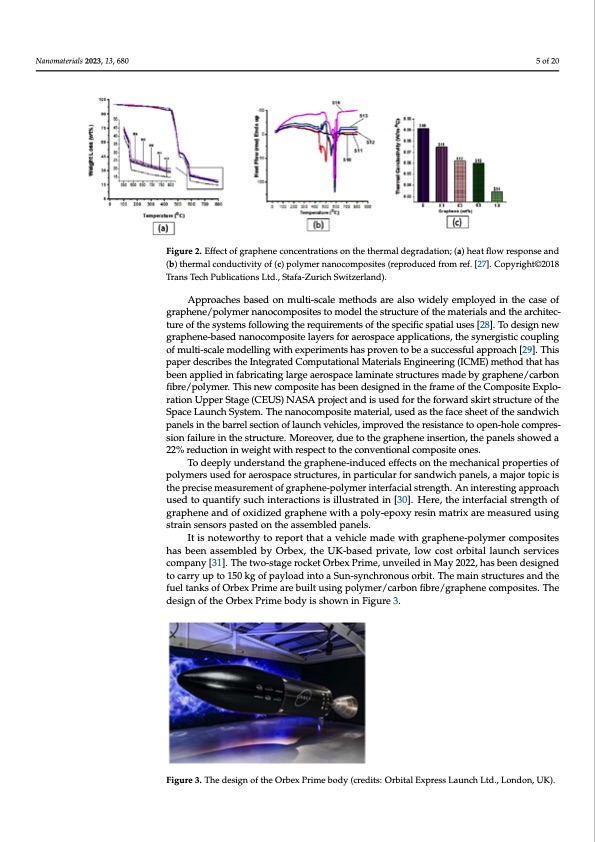PDF Publication Title:
Text from PDF Page: 005
Nanomaterials 2023, 13, 680 5 of 20 Figure 2. Effect of graphene concentrations on the thermal degradation; (a) heat flow response and (b) thermal conductivity of (c) polymer nanocomposites (reproduced from ref. [27]. Copyright©2018 Trans Tech Publications Ltd., Stafa-Zurich Switzerland). Approaches based on multi-scale methods are also widely employed in the case of graphene/polymer nanocomposites to model the structure of the materials and the architec- ture of the systems following the requirements of the specific spatial uses [28]. To design new graphene-based nanocomposite layers for aerospace applications, the synergistic coupling of multi-scale modelling with experiments has proven to be a successful approach [29]. This paper describes the Integrated Computational Materials Engineering (ICME) method that has been applied in fabricating large aerospace laminate structures made by graphene/carbon fibre/polymer. This new composite has been designed in the frame of the Composite Explo- ration Upper Stage (CEUS) NASA project and is used for the forward skirt structure of the Space Launch System. The nanocomposite material, used as the face sheet of the sandwich panels in the barrel section of launch vehicles, improved the resistance to open-hole compres- sion failure in the structure. Moreover, due to the graphene insertion, the panels showed a 22% reduction in weight with respect to the conventional composite ones. To deeply understand the graphene-induced effects on the mechanical properties of polymers used for aerospace structures, in particular for sandwich panels, a major topic is the precise measurement of graphene-polymer interfacial strength. An interesting approach used to quantify such interactions is illustrated in [30]. Here, the interfacial strength of graphene and of oxidized graphene with a poly-epoxy resin matrix are measured using strain sensors pasted on the assembled panels. It is noteworthy to report that a vehicle made with graphene-polymer composites has been assembled by Orbex, the UK-based private, low cost orbital launch services company [31]. The two-stage rocket Orbex Prime, unveiled in May 2022, has been designed to carry up to 150 kg of payload into a Sun-synchronous orbit. The main structures and the fuel tanks of Orbex Prime are built using polymer/carbon fibre/graphene composites. The design of the Orbex Prime body is shown in Figure 3. Figure 3. The design of the Orbex Prime body (credits: Orbital Express Launch Ltd., London, UK).PDF Image | Role of Graphene in Space Technology

PDF Search Title:
Role of Graphene in Space TechnologyOriginal File Name Searched:
nanomaterials-13-00680-v2.pdfDIY PDF Search: Google It | Yahoo | Bing
Salgenx Redox Flow Battery Technology: Power up your energy storage game with Salgenx Salt Water Battery. With its advanced technology, the flow battery provides reliable, scalable, and sustainable energy storage for utility-scale projects. Upgrade to a Salgenx flow battery today and take control of your energy future.
CONTACT TEL: 608-238-6001 Email: greg@infinityturbine.com (Standard Web Page)